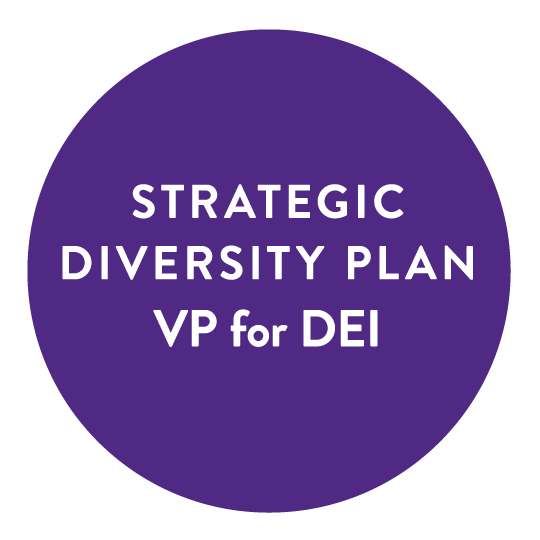The Vision, Mission and Values of Furman University call on the campus community to “promote diversity and foster equity.” The philosophy and practices inherent in The Furman Advantage embody this ideal by encouraging the pursuit of diversity, inclusion and equity as essential components of creating education that transforms, connections that endure and communities that flourish. To accomplish this, we have created a strategic diversity plan that expresses our philosophy around the concept of inclusive excellence while laying out a set of common goals and objectives. Download an overview of the Strategic Diversity Plans as a PDF.
STRATEGIC DIVERSITY PLAN
The institutional values of Furman University call on the campus community to promote diversity and foster equity. The philosophy and practices inherent in The Furman Advantage embody this ideal by encouraging us to pursue the goals of diversity, inclusion and equity as essential components of creating education that transforms, connections that endure and communities that flourish.

INCLUSIVE EXCELLENCE & THE FURMAN ADVANTAGE
Inclusive excellence is a framework designed to support the integration of diversity, equity and inclusion efforts into the core functions and operations of the university while advancing our efforts to obtain educational excellence through The Furman Advantage.

GOAL 1
Improve the recruitment, retention and advancement of students from underrepresented communities.





GOAL 2
Improve the recruitment, retention and advancement of faculty and staff from underrepresented communities.





GOAL 3
Support inclusive excellence within the formal curriculum and within our co-curricular and extra-curricular experiences.





GOAL 4
Engage with our alumni and with local, national and international communities to encourage the pursuit of inclusive excellence beyond the boundaries of Furman’s campus.
Goals & Objectives
1. Improve the recruitment, retention and advancement of students from underrepresented communities.
- Objective A: Create and implement innovative policies and practices that are intentional in their efforts to successfully recruit students from underrepresented communities.
- Objective B: Develop innovative policies and practices to support and retain students from underrepresented communities.
2. Improve the recruitment, retention and advancement of faculty and staff from underrepresented communities
- Objective A: Create and implement innovative policies and practices that are intentional in their efforts to successfully recruit, retain and promote faculty from underrepresented communities
- Objective B: Develop and support professional development opportunities that are intentional in their efforts to successfully train and support staff from underrepresented communities.
3. Support inclusive excellence within the formal curriculum and within our co-curricular and extra-curricular experiences.
- Objective A: Encourage diversity content in and across academic programs, co-curricular activities and the social dimensions of the campus environment
- Objective B: Provide support and professional development for faculty that emphasizes inclusive pedagogy and advising in ways that enhance their ability to address the learning needs of all students
- Objective C: Enhance students’ diversity-related educational opportunities and experiences to ensure that all students are prepared to live and work effectively in a diverse, globally integrated world.
4. Engage with our alumni and with local, national and international communities to encourage the pursuit of inclusive excellence beyond the boundaries of Furman’s campus
- Objective A: Develop a plan to better connect with underrepresented members of our alumni community
- Objective B: Expand relationships with underserved communities in our local and regional area with the intent of growing opportunities for institutional development and impact.
- Objective C: Strengthen initiatives to promote interaction among international and domestic students, faculty, staff and community partners.
Statement on Inclusive Excellence
Inclusive excellence is a framework designed to support the integration of diversity, equity and inclusion efforts into the core functions and operations of the university. Inclusive excellence advances the Furman Advantage by institutionalizing educational equity and reflecting an explicit understanding that diversity, equity and inclusion are catalysts for institutional and educational excellence and are not isolated initiatives.
Beliefs & Values around Inclusive Excellence
In pursuing a transformative vision that embraces institutional excellence, Furman makes the following assertions:
- We acknowledge that we must be truly inclusive in order to be truly excellent
- We aspire to promote meaningful communication, strong support, and shared experiences among people of different identities and life experiences
- We act to remove obstacles to attaining diversity, equity and inclusiveness in the recruitment, retention and advancement of students, faculty, and staff from underrepresented groups.
- We foster in our students a sense of social justice and encourage them to exercise their civic responsibility in creating a fair and equitable order
Definitions of Important Terms and Concepts
To ensure a common understanding of important terms we have also constructed definitions of the most important terms utilized throughout our framework.
- DIVERSITY is the full range of human differences as experienced by groups and individuals that can be engaged in the service of learning. This includes differences in race, ethnicity, gender, socio-economic status, sexual orientation, citizenship status, disability, religion/spirituality, world view, age and many others. A potentially helpful way of thinking about what constitutes diversity is to conceive of diversity in two different spheres. The first is informational or cognitive diversity (which results from what people “know”) and the second is identity diversity (which relates to how people define themselves and others). We believe that both of these forms of diversity are important for advancing the learning and development of our students, faculty and staff within a context that encompasses inclusive excellence and respects the diversity of thought and experience.
- EQUITY refers to the process of creating opportunities for historically underrepresented and underserved populations that encourages equal access in the pursuit of equitable outcomes. Explicit in this process is an effort to end systematic discrimination against people based on their identity and background.
- INCLUSION exists when individuals and groups feel a sense of belonging and are empowered to participate in campus culture as full and valued members of the community who are shaping and redefining that culture in a variety of ways. It recognizes the dignity and worth of all people and strives to ensure that individuals and groups are valued, leveraged and welcomed.
- UNDERREPRESENTED refers to groups that, relative to their demographic presence in the population, have lower than average participation rates in American higher education. Examples of historically underrepresented students/faculty/stuff include but are not limited to: people of color; first-generation; low-income; LGBTQ+; undocumented students; veterans; individuals with disabilities and minoritized religious/spiritual/humanist communities.
Strategic Planning Process
The strategic planning process initially started as an outgrowth of work conducted by the Chief Diversity Officer (CDO). This prework involved formal and informal discussions with administrators, faculty, staff, students, and alumni. This process also reflects experience with Furman’s current diversity efforts; engagement with a variety of diversity themed issues, and an evolving understanding of the numerous components that fuel Furman’s short-term and long-term operations.
In Spring 2020, the process shifted to reflect an evolving partnership with the university wide Diversity & Inclusion Committee. Meetings were held with faculty and with Staff AC to introduce the SDP and to solicit feedback on the draft in Summer 2020. The complexities of opening and managing the COVID crisis temporarily slowed down the advancement of the SDP in Fall 2020. Despite this, revisions were still advanced and in early 2021 the SDP we will be available to the broader campus community. During the Spring 2021 semester the broader campus community will be encouraged to participate in a process that encourages discussion of the plan with an emphasis on strategies and outcomes that support the goals and objectives of the SDP. Following this, the DEI committee, the Senior Administration Team (SAT) and the CDO will consider the input of the campus community and revisit the plan to discuss revisions and adjustments. We expect that a final plan will be ready for implementation in the Fall 2021 semester.
Management
Role of the Chief Diversity Officer
The Chief Diversity Officer will have oversight over the creation and implementation of the SDP and ensures that the progress of the plan is communicated to the campus community. This will require the CDO to work within a context that is highly collaborative given the many divisions and silos that exist within the context of a 21st century liberal arts college. This is also of prime importance because the CDO operates in the context of a “collaborative officer model” where the CDO has no direct reports and relies heavily on voluntary collaboration with others across the university.
Stakeholders & Campus Leaders
One of the primary tenets of strategic diversity leadership is that our efforts to build inclusive excellence cannot operate solely with one individual or within one office. To make our vision a reality will require widespread and shared ownership. With this in mind, our campus leadership will need to take an active role to help with planning and to assist with coordinating campus efforts as the process progresses. This support is being coordinated primarily through meetings between the CDO and other members of the Senior Administrative Team (SAT) and their senior staffs. Other internal and external stakeholders, such as students, faculty, staff, alumni and local community members are asked to take a proactive role in partnering with campus leaders in advancing our efforts.
Accountability
In an effort to facilitate accountability, an internal scorecard charting the progress of the SDP will be maintained by the CDO. This scorecard will include all Goals, Objectives, Strategies and Measures/Outcomes that are part of the SDP. Members of the SAT will work collectively and individually with the CDO to advance the SDP and will be responsible for advancing its goals related to inclusive excellence in their individual areas of responsibility. To this end, an annual report will be produced by the CDO and made available to both the campus community and the public. This report will chart the progress of the plan and makes recommendations for changes to goals, objectives, strategies, etc. Features of this report will allow tracking of the plan’s progress and will clearly identify who or what office or unit is responsible for specific parts of the SDP as well as how and when these efforts will be accomplished. The production of this annual report does not preclude the creation of interim reports or summaries that advise the campus community on the progress of our efforts towards Inclusive Excellence. Implementation of the SDP will be monitored by the CDO who will meet regularly with the DEI committee and the Senior Administrative Team (SAT) to ensure adequate progress.
Planning & Implementation
We fully expect that the campus community will have suggestions and recommendations regarding specific strategies that it would like to see implemented as part of the SDP. These recommendations will be noted and will become part of the discussion around the plan’s implementation. The CDO will continually receive and compile input from the campus community (see info below for specifics) and will regularly engage the DEI committee and the SAT regarding a path forward via the SDP. Receiving input from “open” sources such as email and social media will allow a broad range of constituencies to comment on the SDP and will serve as an especially strong conduit for students, alumni and members of the local community members. Close review by the DEI committee will ensure that our faculty and staff have a voice in shaping both the content and the implementation of the SDP. Lastly, it is important to fully include the members of the SAT in the process as they will have responsibility for implementing, supervising and tracking SDP goals related to their individual areas of responsibility.
Stage One—Preplanning
Creation of a draft version of goals and objectives related to advancing diversity and inclusion at Furman. This stage has included continual input from the DEI committee as well as the Senior Administrative Team.
Stage Two—Drafting & Revising
This is our current phase of work. During this phase we will gather input from the administration, the faculty (starting with the DEI Committee), the staff (starting with Staff AC), and our students via planned virtual events in Summer 2021. This input will be aggregated by the CDO and included as part of discussions with the DEI committee and members of the Senior Administrative Team. Concurrently, the CDO will assist senior administrators in identifying areas of the SDP that are most relevant to the mission of their units. As part of this process, the CDO will work with these administrators (and members of their staffs) as needed to revise the SDP’s objectives (as needed) and to develop relevant strategies and appropriate metrics. This workflow strategy aligns campus wide input with administrative responsibilities in a way that recognizes the importance of advancing shared vision through an approach that utilizes both “bottom up” and “top down” inputs.
To facilitate the input discussed above, we will utilize the following timeline (subject to revision as necessary):
- Online discussion involving Staff AC/Faculty Exec Committee [May—June 2020]
- Online forum for faculty/staff [June 2020]
- Discussion and refinement with CDO, SAT and DEI Committee Chairs [October—November 2020]
- Ongoing Meetings with SAT members and DEI sub-committees to discuss strategies & metrics [April—June 2021]
- Meeting with SAT members and DEI sub-committees to finalize strategies & metrics [April—June 2021]
- Finalize all strategies and metrics—Final preparation for Fall 2021 implementation [June—August 2021]
Stage Three—Implementation
Includes the initial implementation of strategies beginning in Fall 2021 with an emphasis on establishing key performance indicators and accountability. The 2021-2022 academic year will signal the beginning of full implementation. Full implementation represents the completion of at least one full academic year cycle of the SDP as well as the production of the first annual report. It also signals the beginning of a planning phase for both new and ongoing strategies and outcomes for the SDP.
SDP Presentations
The campus community is working together to identify specific actions and strategies that will help advance the university’s efforts toward creating a more diverse and inclusive environment for our community. These efforts are in alignment with and support Furman’s Strategic Diversity Plan (SDP). This work has been shared in a series of presentations hosted by various university divisions. The presentation recordings are included on this page.
Athletics
February 7, 2022
Academic Affairs
September 15, 2021
Development and Alumni and Parent Engagement
August 31, 2021
University Communications Presentation
August 24, 2021
Enrollment Management Presentation
July 29, 2021
Finance and Administration Presentation
July 20, 2021

